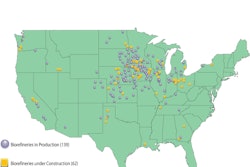
While demand for animal proteins is growing by 2050 demand is expected to double this growth in production volume presents ecological and environmental challenges for the animal production industry.
This leaves many wondering whether animal agriculture will be part of the greenest generation or the grimmest generation?
That was the challenge posed to over 1,700 animal agriculture professionals who attended Alltech's International Animal Health and Nutrition Symposium, where the company's director of worldwide research, Dr. Karl Dawson, said technology exists to keep animal agriculture productive and make it more sustainable.
"The livestock industry's role in solving these problems is as important as anything we will do in agriculture," he said.
Dr. Dawson outlined nine technologies that can help keep animal agriculture productive and sustainable.
No. 1: Nutrient management strategies
Sustainable nutrient management strategies go beyond balancing nutrition to get the most efficient production from the system.
Not merely changing nutrient levels, sustainable systems synchronize nutrients and use appropriate forms of nutrients and minerals something that can decrease waste, while increasing productivity. This technology is real and available now, Dawson said, and involves optimizing feeding systems and precision feeding.
"It is a proven concept showing that you can decrease waste and increase productivity by synchronizing or changing the form of the nutrients going into that system so that it is fully synchronized," he said.
"A simple change in the form of a mineral, for example, can dramatically change required inputs," he said. "And by using the appropriate form of a mineral, excretion can be reduced by 75 percent.
"It's a proven concept that needs to be applied, and quite frankly it's not one that we can afford to ignore..
"We cannot continue to provide exces minerals to animals and expect not to have a major impact on the environment.
"This is something that we are going to have to accept as a practice."
No. 2: Supplementation strategies
Supplementation strategies typically are driven by economics but can be used to decrease environmental impact. These include the use of functional carbohydrates, the use of microbial supplementation, strategic use of minerals and strategic use of antimicrobials.
No. 3: Sequestering waste
Technologies that capture waste and convert it to energy represent new sources of income, not only in the form of the energy harvested but also carbon credits.
No. 4: Novel waste management
Advanced technologies for manure handling, which include aerobic, composting and biofilm reaction systems, can in some cases result in a 99 percent reduction in greenhouse gasses. Their use can yield carbon credits.
No. 5: Developing green feed processing systems
These include enzyme treatments and microbial fermentation systems. Some produce novel high-value ingredients like carbon dioxide, algae and carbohydrates. Microbial proteins from yeast could replace fishmeal as a feed ingredient. This would help reduce overfishing in the world's oceans.
No. 6: The biorefinery
The integration of different components in a biorefinery would produce less waste and can potentially produce designer feeds using natural chemistry. One potential application that would complete the carbon cycle is the production of algae as feed. This application, which sequesters CO2, would be fast and efficient, producing a crop every five days.
No. 7: Enzyme and Microbial Biotechnology
Enzyme and microbial biotechnologies can use orphan crop byproducts (corncobs, wood products, dried distillers grain solubles) as substrates to produce energy.
No. 8: Microbial systems for detoxification
These technologies could make previously toxic feedstuffs available for animal production. Deteriorated or contaminated feed could be rendered wholesome, resulting in an increase in available feeds. Known toxins could be sequestered in feeds.
No. 9: Advanced monitoring
New analytical tools (such as NIR biosensors) used to monitor the health and nutrition of animals can improve efficiency and nutrient utilization.
Live animal production is influential to the quality of the atmosphere, land and soil, water and the planet's biodiversity. While challenges exist, live production can also be an important source of solutions. These solutions could be addressed at reasonable costs.



.jpg?auto=format%2Ccompress&fit=crop&h=167&q=70&w=250)













